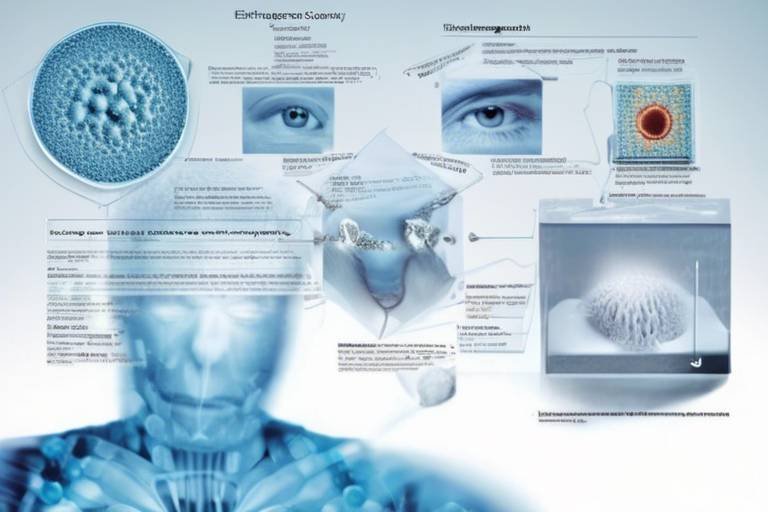Ethical Challenges in Nanotechnology
As we stand on the brink of a technological revolution, nanotechnology emerges as a powerful tool with the potential to reshape our world. But, with great power comes great responsibility. The ethical challenges posed by this innovative field are profound and multifaceted. From the safety of nanomaterials to their environmental impact, and from regulatory frameworks to public perception, the implications of nanotechnology demand our attention and careful consideration.
One of the most pressing issues in the realm of nanotechnology is the safety concerns associated with nanomaterials. These tiny particles, often measured in nanometers, can exhibit unique properties that differ significantly from their larger counterparts. This raises questions about their potential risks to human health and the environment. Are we fully aware of the long-term effects of exposure to these materials? Rigorous testing and regulation are essential before we can confidently integrate them into our everyday lives.
Moreover, establishing an effective regulatory framework is crucial. The rapid pace of advancements in nanotechnology presents a challenge for lawmakers and scientists alike. Collaboration among governments, industries, and researchers is necessary to create comprehensive guidelines that can ensure safety and efficacy. Currently, many existing regulations are outdated and fail to address the unique challenges posed by nanotechnology.
- What are the main ethical concerns regarding nanotechnology? The main concerns include safety risks, environmental impact, equity and access, and the need for responsible innovation.
- How can we ensure public safety with nanotechnology? By implementing rigorous testing, establishing clear regulations, and promoting transparency in research and development.
- Why is public perception important in the context of nanotechnology? Public acceptance is crucial for the successful adoption of nanotechnology, and it is influenced by safety concerns and ethical implications.
- What role do international standards play in nanotechnology? International standards help facilitate cooperation among countries, ensuring consistent safety measures and promoting responsible innovation.

Safety Concerns
When we dive into the world of nanotechnology, one of the first things that pops up is the looming question of safety. With the potential for nanomaterials to revolutionize industries ranging from medicine to electronics, the stakes couldn't be higher. However, alongside this promise lies a shadow of uncertainty, particularly regarding the risks these tiny particles may pose to both human health and the environment.
The fact that nanomaterials are so small—often at the atomic or molecular level—means they can behave differently from their larger counterparts. This unique behavior raises significant safety concerns that cannot be brushed aside. For instance, how do these materials interact with biological systems? What are the long-term effects of exposure? These questions need to be answered through rigorous testing and regulation before we fully embrace their widespread use.
To put it simply, we need a robust framework to assess the safety of nanomaterials. This framework should include:
- Comprehensive Testing: Before any nanomaterial hits the market, it should undergo extensive testing to evaluate its potential health risks. This includes toxicity studies and environmental impact assessments.
- Long-Term Studies: Short-term studies are not enough. We need long-term data to understand the implications of prolonged exposure to nanomaterials.
- Public Health Monitoring: Continuous monitoring of public health outcomes related to nanotechnology use will help identify any emerging risks.
Moreover, the regulatory landscape surrounding nanotechnology is still evolving. Governments and regulatory bodies are grappling with how to effectively manage these new materials. The challenge lies in balancing innovation with safety. If we move too quickly without adequate safeguards, we could be opening Pandora's box. On the other hand, overly stringent regulations could stifle innovation, preventing us from unlocking the full potential of nanotechnology.
In light of these concerns, it's crucial for stakeholders—including scientists, policymakers, and the public—to engage in open dialogues about safety protocols. Transparency in research and development processes can lead to better-informed decisions that prioritize public health and environmental sustainability.
As we move forward, the ethical implications of safety in nanotechnology cannot be ignored. We must ask ourselves: Are we willing to take the risks associated with these groundbreaking materials? The answer lies in a collective commitment to responsible innovation, ensuring that safety is at the forefront of our technological advancements.
- What are nanomaterials? Nanomaterials are materials that have structural components smaller than 100 nanometers, which can exhibit unique properties compared to larger-scale materials.
- Why are safety concerns significant in nanotechnology? Due to their small size, nanomaterials can behave differently in biological systems and the environment, leading to potential health risks that need thorough investigation.
- How can we ensure the safety of nanomaterials? Implementing comprehensive testing, long-term studies, and public health monitoring are essential steps to ensure the safety of nanomaterials before they are widely used.

Regulatory Framework
The landscape of nanotechnology is evolving at an unprecedented pace, and with it, the need for a robust becomes increasingly crucial. This framework serves as the backbone for ensuring that innovations in nanotechnology are not only effective but also safe for both humans and the environment. As we navigate this complex terrain, it is essential for governments, industries, and scientists to collaborate closely to establish comprehensive guidelines and standards that reflect the unique challenges posed by nanomaterials.
One of the primary objectives of a regulatory framework is to address safety concerns associated with nanotechnology. This involves rigorous testing protocols that assess the potential risks of nanomaterials before they are introduced to the market. The framework must also be adaptable, allowing for the rapid advancements in technology that often outpace existing regulations. For instance, as new nanomaterials are developed, they may exhibit unforeseen properties that could pose safety risks. Therefore, it is vital to incorporate a mechanism for continuous review and update of regulations, ensuring they remain relevant and effective.
Currently, various regulations govern the use of nanotechnology, but many gaps exist that hinder effective enforcement. For example, regulations may vary significantly from one country to another, leading to inconsistencies in safety measures. Identifying these gaps is crucial for developing a cohesive regulatory approach. A comprehensive overview of existing regulations can be summarized in the following table:
| Country | Regulatory Body | Key Regulations |
|---|---|---|
| United States | Environmental Protection Agency (EPA) | Toxic Substances Control Act (TSCA) |
| European Union | European Chemicals Agency (ECHA) | REACH Regulation |
| Canada | Health Canada | Canadian Environmental Protection Act (CEPA) |
As illustrated in the table, while some countries have established regulatory bodies and frameworks, others may not have comprehensive guidelines specifically tailored for nanotechnology. This inconsistency highlights the urgent need for international collaboration to create uniform standards that can be applied globally.
The development of international standards is vital for fostering global cooperation in nanotechnology. By establishing consistent safety measures, countries can work together to promote responsible innovation across borders. These standards can facilitate trade and ensure that products containing nanomaterials meet safety criteria, regardless of where they are produced. Moreover, the harmonization of regulations can help mitigate risks associated with the transboundary movement of nanomaterials.
On the national level, policies must evolve to address the unique challenges posed by nanotechnology. This requires a delicate balance between fostering innovation and ensuring public safety and environmental protection. Policymakers must engage with a variety of stakeholders, including researchers, industry leaders, and the public, to create policies that reflect a broad spectrum of perspectives. By doing so, they can enhance the legitimacy of regulatory frameworks and encourage sustainable development that benefits all.
Looking ahead, the regulatory landscape for nanotechnology must be proactive rather than reactive. This involves not only assessing emerging technologies but also anticipating their implications. Ethical considerations should remain at the forefront of policy development, guiding decisions that affect public health and environmental sustainability. As we continue to explore the potential of nanotechnology, it is essential to remember that the goal is not just innovation for its own sake, but innovation that respects and enhances the well-being of society as a whole.
- What are the main safety concerns related to nanotechnology?
Safety concerns include potential toxicity of nanomaterials, their environmental impact, and unknown long-term effects on human health.
- How do current regulations address nanotechnology?
Current regulations vary by country and may not adequately cover the unique aspects of nanotechnology, leading to gaps in safety measures.
- Why is international cooperation important in nanotechnology regulation?
International cooperation helps create consistent safety standards, facilitating trade and ensuring that nanomaterials are safe regardless of where they are produced.

Current Regulations
When it comes to the surrounding nanotechnology, the landscape is a bit like a patchwork quilt—full of gaps, inconsistencies, and a few frayed edges. Different countries have adopted varying approaches to regulating nanomaterials, which can lead to confusion and uncertainty not only for manufacturers but also for consumers. In the United States, for instance, the Environmental Protection Agency (EPA) oversees the regulation of nanomaterials under the Toxic Substances Control Act (TSCA). However, the challenge lies in the fact that many existing regulations were not designed with nanotechnology in mind, leaving significant loopholes that can compromise safety.
In Europe, the situation is somewhat more structured due to the REACH (Registration, Evaluation, Authorisation and Restriction of Chemicals) regulation, which requires manufacturers to register their nanomaterials and provide safety data. Yet, even this framework has its limitations. For example, the definitions of what constitutes a nanomaterial can vary, leading to inconsistencies in how regulations are applied across different jurisdictions. This lack of uniformity can create hurdles for companies looking to operate internationally, as they must navigate a maze of regulations that may not align.
Moreover, the rapid pace of innovation in nanotechnology often outstrips the ability of regulatory bodies to keep up. As new applications emerge—from medicine to electronics—the need for updated regulations becomes even more pressing. The existing frameworks often lack the flexibility required to adapt to these advancements. For example, while some nanomaterials have been approved for use, there are still many that remain untested, raising concerns about their potential long-term effects on human health and the environment.
To illustrate the current state of nanotechnology regulations, consider the following table that outlines key regulatory bodies and their roles:
| Region | Regulatory Body | Key Regulation |
|---|---|---|
| United States | Environmental Protection Agency (EPA) | Toxic Substances Control Act (TSCA) |
| Europe | European Chemicals Agency (ECHA) | REACH Regulation |
| Canada | Health Canada | Canadian Environmental Protection Act (CEPA) |
| Australia | National Industrial Chemicals Notification and Assessment Scheme (NICNAS) | Industrial Chemicals Act |
As we can see, while there are regulatory frameworks in place, the effectiveness of these regulations is often hampered by a lack of comprehensive data on the safety and environmental impact of nanomaterials. This highlights the urgent need for collaboration among governments, industries, and scientists to establish a more cohesive and robust regulatory framework. Only by working together can we bridge the gaps and ensure that nanotechnology is developed responsibly and safely.
In conclusion, the current regulations governing nanotechnology are a mixed bag. While there are frameworks in place, they often fall short in addressing the unique challenges posed by this rapidly evolving field. The need for updated, consistent, and globally recognized regulations is more critical than ever to safeguard public health and the environment while fostering innovation.
- What are nanomaterials? Nanomaterials are materials with structures at the nanoscale, typically measuring between 1 and 100 nanometers.
- Why is regulation important for nanotechnology? Regulation is crucial to ensure the safety and efficacy of nanomaterials, protecting public health and the environment from potential risks.
- Are there international regulations for nanotechnology? While there are some international guidelines, regulations vary significantly between countries, leading to inconsistencies.
- How can the public stay informed about nanotechnology? Engaging with trusted sources, attending public discussions, and following scientific updates can help the public stay informed.

International Standards
The development of for nanotechnology is a crucial step toward ensuring consistent safety measures and responsible innovation across the globe. As nanotechnology continues to evolve at a rapid pace, the absence of universal guidelines can lead to disparities in safety practices, regulatory compliance, and public trust. Establishing these standards is not merely a bureaucratic necessity; it is an ethical obligation to protect human health and the environment while fostering technological advancement.
International standards can facilitate global cooperation among countries, industries, and research institutions. By creating a common framework, stakeholders can work together to address the challenges posed by nanotechnology. For instance, these standards can cover various aspects, including:
- Safety Testing: Establishing protocols for assessing the safety of nanomaterials before they are introduced to the market.
- Environmental Impact Assessments: Guidelines for evaluating how nanomaterials interact with ecosystems and their long-term effects.
- Quality Control: Standards to ensure that products containing nanomaterials meet safety and efficacy benchmarks.
Moreover, the establishment of international standards can help mitigate the risks associated with the global marketplace. Companies operating in multiple countries need to adhere to varying regulations, which can lead to confusion and compliance challenges. A unified set of standards would provide clarity, allowing businesses to innovate without compromising safety or ethical considerations.
However, developing these standards is not without its challenges. It requires a collaborative effort among various stakeholders, including governments, industry leaders, scientists, and the public. This collaboration is essential to ensure that the standards are comprehensive, scientifically sound, and reflective of societal values. Additionally, ongoing dialogue is necessary to adapt these standards as new research emerges and technologies evolve.
In summary, the creation of international standards for nanotechnology is a vital component of responsible innovation. It promotes safety, fosters public trust, and paves the way for sustainable development. Without these standards, the potential of nanotechnology may be undermined by ethical dilemmas and public skepticism. As we move forward, it is imperative that we prioritize the establishment of these guidelines to harness the full benefits of this transformative technology.
Q1: What are international standards in nanotechnology?
International standards in nanotechnology refer to established guidelines and protocols that govern the safe and responsible use of nanomaterials across different countries. These standards aim to ensure consistent safety measures and promote public trust.
Q2: Why are international standards necessary?
They are necessary to address the disparities in safety practices and regulatory compliance across countries, ensuring that nanotechnology is developed and used responsibly while protecting human health and the environment.
Q3: Who is involved in creating these standards?
The creation of international standards involves a collaborative effort among governments, industry leaders, scientists, and the public to ensure that the guidelines are comprehensive and reflective of societal values.
Q4: How do these standards affect innovation?
International standards can facilitate innovation by providing clarity and consistency, allowing companies to develop new nanotechnology products without compromising safety or ethical considerations.

National Policies
When it comes to nanotechnology, national policies play a pivotal role in shaping the landscape of innovation while safeguarding public health and the environment. As this field evolves at a breakneck speed, it becomes increasingly crucial for policymakers to adapt their strategies to address the unique challenges posed by these cutting-edge technologies. The balance between fostering innovation and ensuring safety is delicate, and national policies must be designed with this balance in mind.
One of the key aspects of effective national policies is the establishment of comprehensive regulatory frameworks that can keep pace with the rapid advancements in nanotechnology. This involves not only creating guidelines for the safe use of nanomaterials but also ensuring that these guidelines are regularly updated as new research emerges. Policymakers must collaborate with scientists, industry leaders, and public health experts to develop regulations that are both practical and forward-thinking.
Moreover, national policies should prioritize public engagement and transparency. By involving the public in discussions about nanotechnology, policymakers can build trust and address concerns that may arise. This can be achieved through:
- Public consultations and forums
- Educational campaigns to raise awareness about the benefits and risks of nanotechnology
- Opportunities for stakeholders to provide input on policy decisions
Additionally, it is essential for national policies to recognize the global nature of nanotechnology. As research and development transcend borders, nations must work together to establish harmonized standards that ensure safety and efficacy. This cooperation can help prevent a patchwork of regulations that could stifle innovation and create confusion within the industry.
In summary, the formulation of national policies regarding nanotechnology must be a dynamic and inclusive process. By prioritizing safety, public engagement, and international collaboration, countries can harness the potential of nanotechnology while mitigating its associated risks. The ultimate goal is to promote sustainable development that benefits all sectors of society, paving the way for a future where innovation and safety go hand in hand.
- What is nanotechnology? Nanotechnology refers to the manipulation of matter on an atomic or molecular scale, typically at dimensions between 1 and 100 nanometers.
- Why are national policies important for nanotechnology? National policies are crucial to ensure the safe and responsible development of nanotechnology, balancing innovation with public health and environmental protection.
- How can the public engage with nanotechnology policies? The public can engage through consultations, educational initiatives, and by providing feedback during policy development processes.
- What are the risks associated with nanotechnology? Potential risks include health impacts from exposure to nanomaterials, environmental concerns, and ethical implications regarding access and equity.
- How can international cooperation enhance nanotechnology regulation? International cooperation can lead to the establishment of consistent safety standards, promoting responsible innovation across borders and preventing regulatory discrepancies.

Future Directions
As we look ahead, the landscape of nanotechnology is poised for remarkable transformations, driven by the rapid pace of innovation and the increasing complexity of societal needs. The for nanotechnology must be carefully navigated to ensure that ethical considerations remain at the forefront of development. This involves a multifaceted approach that not only addresses technological advancements but also contemplates their societal implications.
One of the critical areas for future exploration is the integration of emerging technologies with nanotechnology. For instance, the convergence of nanotechnology with artificial intelligence (AI) and biotechnology could lead to groundbreaking applications in medicine, energy, and environmental sustainability. However, as we embrace these advancements, we must ask ourselves: How do we ensure that these technologies are developed responsibly? The answer lies in fostering a culture of collaboration among scientists, policymakers, and the public.
Moreover, the development of comprehensive regulatory frameworks is essential. These frameworks should not only focus on safety and efficacy but also consider the ethical implications of new technologies. For example, as nanotechnology advances into fields like gene editing and personalized medicine, we must develop guidelines that protect individual rights while promoting innovation. This requires an ongoing dialogue between stakeholders to adapt regulations that can keep pace with technological advancements.
Another vital aspect is the inclusivity of diverse perspectives in the decision-making process. Engaging various stakeholders—ranging from scientists and industry leaders to community members and ethicists—can lead to more holistic and ethical outcomes. Public forums and collaborative workshops can serve as platforms for discussing the potential benefits and risks associated with nanotechnology, ensuring that all voices are heard and considered.
Furthermore, as we explore the future of nanotechnology, we must remain vigilant about its environmental impact. Conducting thorough assessments, such as life cycle analyses, can help us understand the long-term effects of nanomaterials on ecosystems. This knowledge is crucial for developing sustainable practices that minimize negative environmental consequences while maximizing the benefits of nanotechnology.
In conclusion, the future of nanotechnology holds immense promise, but it is imperative that we approach it with a strong ethical framework. By prioritizing responsible innovation, fostering collaboration, and engaging the public, we can navigate the challenges ahead and ensure that nanotechnology serves as a force for good in society.
- What are the main ethical concerns surrounding nanotechnology?
Ethical concerns include safety risks, environmental impacts, equity in access, and the potential for misuse of nanotechnology. - How can we ensure the safety of nanomaterials?
Ensuring safety involves rigorous testing, regulatory oversight, and ongoing risk assessments to monitor their effects on health and the environment. - Why is public engagement important in nanotechnology?
Public engagement fosters transparency, builds trust, and ensures that diverse perspectives are considered in decision-making processes. - What role do international standards play in nanotechnology?
International standards help create a consistent framework for safety and efficacy, promoting responsible innovation across borders. - How can we promote responsible innovation in nanotechnology?
Promoting responsible innovation involves adopting ethical research practices, prioritizing societal well-being, and ensuring equitable access to benefits.

Public Perception
The way the public perceives nanotechnology is a crucial factor that can either propel or hinder its acceptance and integration into society. Imagine standing at a crossroads, where one path leads to innovation and the other to skepticism. The public's understanding—or lack thereof—plays a significant role in determining which way we go. Concerns about safety, ethical implications, and the potential for misuse often cloud the conversation surrounding this cutting-edge technology. It's like trying to navigate a foggy road; without clear visibility, it's easy to feel lost and uncertain.
To truly grasp the public's perception of nanotechnology, we must first consider the various factors that influence it. For instance, media coverage can shape opinions dramatically. If news outlets highlight the risks associated with nanomaterials without balancing that narrative with their benefits, public sentiment can skew negative. This is where effective risk communication becomes vital. By educating the public about both the advantages and potential downsides of nanotechnology, we can foster a more informed discussion. Imagine a scale: on one side, we have the fears and misconceptions, and on the other, the facts and benefits. The goal is to tip that scale in favor of understanding.
Moreover, engaging diverse stakeholders in discussions about nanotechnology is essential for building trust and transparency. When scientists, policymakers, industry leaders, and the general public come together, it creates a rich tapestry of perspectives that can lead to more ethical decision-making. This engagement can take various forms—public forums, community workshops, or even online platforms where people can voice their concerns and questions. By actively involving the community, we not only demystify nanotechnology but also empower individuals to participate in shaping its future.
Consider the following key points that influence public perception:
- Safety Concerns: The fear of unknown risks associated with nanomaterials can lead to public apprehension.
- Ethical Implications: Questions about the morality of using certain technologies can create skepticism.
- Potential for Misuse: Concerns about how nanotechnology might be exploited can further complicate public sentiment.
Ultimately, the challenge lies in bridging the gap between scientific advancements and public understanding. As we continue to explore the vast potential of nanotechnology, we must remain vigilant in our efforts to communicate effectively and engage meaningfully with the public. This is not just about technology; it's about building a future where everyone can benefit from innovation without fear or misunderstanding.
| Question | Answer |
|---|---|
| What is nanotechnology? | Nanotechnology involves manipulating matter on an atomic or molecular scale, typically at sizes between 1 and 100 nanometers. |
| Why is public perception important? | Public perception influences the acceptance and regulation of nanotechnology, impacting its development and application. |
| How can we improve public understanding of nanotechnology? | Through effective risk communication, community engagement, and transparent discussions about its benefits and risks. |

Risk Communication
When it comes to nanotechnology, effective is not just a nice-to-have; it's an absolute necessity. Imagine trying to explain the intricacies of a technology that operates at the atomic level to someone who might not even know what a nanometer is! It's a challenge, but it's also an opportunity to bridge the gap between complex science and everyday understanding. The goal here is to educate the public about the potential benefits and risks associated with nanotechnology, all while addressing their fears and misconceptions.
First and foremost, it's crucial to recognize that the public's perception of risk is often influenced by emotions rather than facts. This means that simply presenting data won’t cut it. Instead, we need to create narratives that resonate with people's experiences and values. For instance, if we can relate nanotechnology to everyday products—like sunscreen that uses nanoparticles for better UV protection—people are more likely to engage with the topic. By framing the conversation around familiar concepts, we can demystify nanotechnology and make it more approachable.
Moreover, transparency is key in risk communication. Stakeholders, including scientists, policymakers, and industry leaders, must be open about what is known and what remains uncertain. Acknowledging the limitations of our current understanding is essential for building trust. When people feel that they are being given the full picture, they are more likely to participate in discussions and voice their concerns. This is where effective communication strategies come into play:
- Utilizing Clear Language: Avoid jargon and technical terms that can alienate the audience. Instead, use simple, relatable language.
- Engaging Visuals: Infographics and videos can simplify complex information and make it more digestible.
- Two-Way Communication: Create platforms for dialogue where the public can ask questions and express their concerns. This could be through forums, social media, or community meetings.
Additionally, we can't overlook the role of education. Schools and universities should incorporate nanotechnology into their curricula to equip future generations with the knowledge they need to understand and engage with this technology. When young minds are educated about the implications of nanotechnology, they can become advocates for responsible innovation and informed decision-making.
In summary, effective risk communication in nanotechnology is about more than just sharing information; it's about fostering understanding, building trust, and encouraging public engagement. By adopting clear communication strategies and promoting education, we can ensure that everyone has a seat at the table as we navigate the exciting—and sometimes daunting—world of nanotechnology.
Q1: What is nanotechnology?
Nanotechnology is the manipulation of matter on an atomic or molecular scale, typically at dimensions between 1 and 100 nanometers. It has applications in various fields, including medicine, electronics, and materials science.
Q2: Why is risk communication important in nanotechnology?
Risk communication is vital in nanotechnology because it helps the public understand the potential benefits and risks associated with nanomaterials, fostering informed discussions and building trust in technological advancements.
Q3: How can the public engage in discussions about nanotechnology?
The public can engage in discussions about nanotechnology by participating in community forums, attending public meetings, and utilizing social media platforms to ask questions and share concerns with stakeholders.
Q4: What role does education play in understanding nanotechnology?
Education plays a crucial role in understanding nanotechnology by equipping individuals with the knowledge needed to comprehend its implications, fostering critical thinking, and encouraging responsible innovation.

Engagement Strategies
Engaging diverse stakeholders in discussions about nanotechnology is not just a good idea; it’s essential for fostering a culture of transparency and trust. When we think about the rapid advancements in technology, it’s easy to feel overwhelmed, right? But what if we could break down those barriers and make the conversation accessible to everyone? By actively involving the public, scientists, policymakers, and industry leaders, we can create a more inclusive dialogue that respects ethical considerations and addresses societal concerns.
One effective approach is to organize community forums and workshops where people can voice their opinions and ask questions about nanotechnology. Imagine a local gathering where scientists explain their work in simple terms, allowing community members to engage directly with the experts. This not only demystifies the technology but also empowers the public to express their thoughts and anxieties. Public engagement can take various forms:
- Workshops: Hands-on sessions where participants can learn about nanotechnology applications.
- Webinars: Online discussions that reach a broader audience, making it easier for people to participate from anywhere.
- Surveys: Gathering public opinions and concerns through structured questionnaires.
Furthermore, utilizing social media platforms can be a game-changer. By sharing informative content, infographics, and videos that explain the implications of nanotechnology, we can engage a wider audience. These platforms allow for real-time feedback, which is invaluable for understanding public sentiment. It’s like having a direct line to the community’s thoughts and feelings, helping us to adapt our strategies accordingly.
Another key aspect is to involve underrepresented communities in these discussions. Ensuring that everyone has a voice—especially those who might be disproportionately affected by technological advancements—can lead to more equitable outcomes. It’s crucial to recognize that not all communities have the same access to information or resources. Tailoring engagement strategies to meet the needs of diverse groups can help bridge this gap.
In summary, effective engagement strategies are all about creating a two-way street. It’s not just about informing the public; it’s about listening to their concerns and integrating their insights into the decision-making process. By fostering a culture of collaboration and open dialogue, we can ensure that ethical considerations remain at the forefront of nanotechnology development, ultimately leading to innovations that benefit everyone.
| Question | Answer |
|---|---|
| What is nanotechnology? | Nanotechnology involves manipulating matter on an atomic or molecular scale, typically at sizes between 1 and 100 nanometers, to create new materials and devices. |
| Why is public engagement important in nanotechnology? | Public engagement helps build trust, addresses safety concerns, and ensures that diverse perspectives are considered in the development and regulation of nanotechnology. |
| How can I get involved in discussions about nanotechnology? | You can participate in community forums, webinars, or engage with organizations that focus on nanotechnology and its implications. |
| What are the ethical concerns surrounding nanotechnology? | Ethical concerns include safety risks, environmental impact, equity in access, and the need for informed consent in research practices. |

Environmental Impact
The environmental impact of nanotechnology presents a complex tapestry of ethical challenges that we must carefully navigate. As we dive into the realm of nanomaterials, we must ask ourselves: how do these tiny particles affect our ecosystems? The reality is that their interactions with the environment can be as intricate as the materials themselves. For instance, while nanotechnology holds the promise of creating more efficient products, it also raises questions about the long-term effects of these materials on biodiversity and ecological balance.
One of the primary concerns is the potential for nanomaterials to accumulate in the environment. These materials can enter ecosystems through various pathways, such as wastewater, air emissions, or even through consumer products. Once introduced, they may interact with living organisms in unforeseen ways. For example, nanoparticles can be absorbed by plants, potentially entering the food chain and affecting not just plant life, but also the animals and humans that rely on these plants for sustenance.
To better understand the environmental footprint of nanotechnology, conducting a Life Cycle Analysis (LCA) is essential. This comprehensive assessment evaluates the environmental impacts of a product from its inception to disposal. By analyzing each stage of a nanomaterial's life cycle, researchers can gain insights into:
| Life Cycle Stage | Potential Environmental Impact |
|---|---|
| Raw Material Extraction | Resource depletion, habitat destruction |
| Manufacturing | Energy consumption, waste generation |
| Usage | Release of nanomaterials into the environment |
| Disposal | Leaching of harmful substances, contamination of soil and water |
Moreover, the issue of biodegradability is another critical factor in assessing the environmental impact of nanotechnology. Many nanomaterials are engineered to be stable and persistent, which can lead to concerns about their accumulation in natural systems. Understanding the biodegradability of these materials is crucial for informing responsible production and disposal practices. If nanomaterials do not break down effectively, they could pose long-term risks to both human health and the environment.
In summary, the environmental implications of nanotechnology are profound and multifaceted. As we embrace the innovations that come with these advancements, we must also commit to rigorous research and ethical considerations. Only through a balanced approach can we harness the benefits of nanotechnology while safeguarding our planet for future generations.
- What are nanomaterials? Nanomaterials are materials with structures at the nanoscale, typically between 1 and 100 nanometers in size. They exhibit unique properties compared to their larger counterparts.
- How do nanomaterials affect the environment? Nanomaterials can interact with ecosystems in complex ways, potentially leading to accumulation in food chains and impacting biodiversity.
- Why is life cycle analysis important for nanotechnology? Life cycle analysis helps assess the environmental impacts of nanomaterials throughout their entire life cycle, guiding sustainable practices.
- Are all nanomaterials biodegradable? No, many nanomaterials are designed to be stable and may persist in the environment, raising concerns about their long-term effects.
- What steps can be taken to mitigate the environmental impact of nanotechnology? Conducting thorough research, implementing effective regulations, and promoting responsible production and disposal practices are essential steps.

Life Cycle Analysis
Life Cycle Analysis (LCA) is an essential tool for understanding the environmental impact of nanomaterials throughout their entire lifespan. This comprehensive evaluation examines every stage of a product's life, from raw material extraction to production, usage, and eventual disposal. By applying LCA to nanotechnology, we can uncover critical insights that guide the development of more sustainable practices. Think of it as a detective story where every clue helps us piece together the bigger picture of a material's ecological footprint.
One of the most significant advantages of conducting a life cycle analysis is that it allows researchers and manufacturers to identify potential environmental hotspots. These hotspots are stages in the product life cycle where the environmental impact is greatest, offering opportunities for improvement. For instance, if a specific nanomaterial is found to have a high carbon footprint during its manufacturing phase, steps can be taken to modify the production process to reduce emissions.
Moreover, LCA can help in comparing various nanomaterials to determine which ones are more environmentally friendly. This comparative analysis can be crucial for industries looking to adopt greener alternatives. For example, when evaluating two different types of nanomaterials used in a product, LCA can reveal which material has a lower impact on water usage, energy consumption, or toxicity to ecosystems. This information is invaluable for making informed decisions that align with sustainability goals.
However, it's important to note that conducting a life cycle analysis is not without its challenges. The complexity of nanomaterials and their interactions with the environment can make it difficult to gather accurate data. Additionally, the rapid pace of innovation in nanotechnology means that LCA methodologies must continually evolve to keep up with new developments. Therefore, collaboration among scientists, environmentalists, and industry leaders is crucial to refine LCA approaches and ensure they are relevant and effective.
In conclusion, Life Cycle Analysis serves as a powerful framework for assessing the environmental impacts of nanotechnology. By meticulously analyzing each stage of a product's life, we can make informed decisions that promote sustainability and minimize adverse effects on our planet. As we move forward in the realm of nanotechnology, embracing LCA will be vital for fostering innovation that is not only cutting-edge but also environmentally responsible.
- What is Life Cycle Analysis (LCA)?
LCA is a systematic approach for evaluating the environmental impacts of a product throughout its entire life cycle, from raw material extraction to disposal. - Why is LCA important for nanotechnology?
LCA helps identify the environmental hotspots associated with nanomaterials, guiding manufacturers towards more sustainable practices. - What challenges does LCA face?
Challenges include the complexity of nanomaterials, difficulties in data collection, and the need for methodologies to keep pace with rapid advancements in technology. - How can LCA influence decision-making?
By providing insights into the environmental impacts of different materials, LCA enables manufacturers to make informed choices that align with sustainability goals.

Biodegradability Concerns
When we talk about nanotechnology, one of the biggest questions that pops up is: What happens to these tiny materials once they’ve served their purpose? The issue of biodegradability is crucial because it directly impacts our environment. Nanomaterials, due to their unique properties, can behave differently than larger particles. This raises concerns about their persistence in ecosystems and the potential risks they pose to wildlife and human health.
To grasp the magnitude of this issue, consider the following: many nanomaterials are engineered to be durable and resistant to degradation. While this might be beneficial for certain applications, it also means they could linger in the environment for extended periods. Think of it like a plastic bottle that takes hundreds of years to decompose; nanomaterials could similarly accumulate, leading to unforeseen ecological consequences.
Moreover, the biodegradation process itself can vary significantly based on the material composition and environmental conditions. For instance, some nanomaterials may break down in the presence of specific microorganisms, while others might not degrade at all. This unpredictability can complicate risk assessments and regulatory measures. To better understand these dynamics, researchers often conduct life cycle analyses (LCAs) that evaluate the environmental impact of nanomaterials from production to disposal.
| Nanomaterial Type | Biodegradability | Environmental Impact |
|---|---|---|
| Carbon Nanotubes | Low | Potential accumulation in soil and water |
| Silver Nanoparticles | Moderate | Toxicity to aquatic life |
| Silica Nanoparticles | High | Generally considered safe, minimal impact |
The table above illustrates the varying degrees of biodegradability among different nanomaterials. As we can see, not all nanomaterials are created equal when it comes to environmental impact. This brings us to an important point: research is ongoing, and scientists are actively exploring ways to develop nanomaterials that are both effective and environmentally friendly. Innovations in this field could lead to the creation of biodegradable nanomaterials that break down naturally and safely, minimizing their ecological footprint.
In conclusion, the concerns surrounding biodegradability in nanotechnology are not just scientific curiosities; they are pressing ethical dilemmas that demand our attention. As we move forward with the development and application of nanotechnology, it is imperative that we prioritize research into the environmental impacts of these materials. By doing so, we can ensure that we are not only advancing technology but also protecting our planet for future generations.
- What are nanomaterials? Nanomaterials are materials with structures at the nanoscale, typically between 1 and 100 nanometers in size.
- Why is biodegradability important? Biodegradability is crucial because it determines how long a material will persist in the environment and its potential impact on ecosystems.
- Are all nanomaterials harmful to the environment? Not all nanomaterials are harmful; their impact varies based on their composition and how they interact with the environment.
- What can be done to improve the biodegradability of nanomaterials? Ongoing research aims to develop biodegradable nanomaterials and improve existing materials' environmental profiles.

Equity and Access
The ethical implications of equity and access in nanotechnology are increasingly coming to the forefront of discussions surrounding this innovative field. As we delve into the world of nanotechnology, it’s crucial to recognize that not all communities have equal access to the benefits it promises. This disparity can lead to significant ethical dilemmas, where some populations may reap the rewards of advancements while others are left behind, exacerbating existing inequalities.
Ensuring equitable access to nanotechnology is not just a matter of fairness; it’s a pathway to promoting inclusivity and innovation. Imagine a world where the latest breakthroughs in nanomedicine or environmental remediation are only available to a select few. This scenario not only undermines the potential of nanotechnology but also raises questions about who gets to decide which communities benefit from these advancements. Addressing these issues requires a multifaceted approach:
- Access to Technology: It’s essential to create frameworks that ensure marginalized communities can access and benefit from nanotechnology. This could involve educational programs, funding for research in underrepresented areas, and partnerships with local organizations to facilitate technology transfer.
- Global Disparities: The landscape of nanotechnology research and development is not uniform across the globe. Wealthier nations often lead in innovation, while developing countries may struggle to keep pace. International cooperation is crucial to bridge this gap, ensuring that advancements are accessible and beneficial to all nations.
To illustrate the disparities in access to nanotechnology, consider the following table that highlights the differences in research funding across various regions:
| Region | Research Funding (in Millions) | Access to Nanotechnology |
|---|---|---|
| North America | $500 | High |
| Europe | $300 | High |
| Asia | $200 | Medium |
| Africa | $50 | Low |
This table starkly illustrates the funding disparities that exist and how they correlate with access to technology. As we move forward, it’s imperative to address these inequities head-on. Collaborative efforts among governments, industries, and academic institutions can pave the way for more inclusive practices in nanotechnology.
In conclusion, equity and access in nanotechnology are not just ethical considerations; they are essential components of responsible innovation. By actively working to ensure that all communities can participate in and benefit from advancements, we can foster a more inclusive future where the transformative potential of nanotechnology is realized by everyone, not just a privileged few.
Q1: What is nanotechnology?
Nanotechnology involves manipulating matter at the atomic and molecular levels to create new materials and devices with unique properties.
Q2: Why is equity important in nanotechnology?
Equity ensures that all communities have access to the benefits of nanotechnology, preventing disparities that can exacerbate existing social and economic inequalities.
Q3: How can we promote equitable access to nanotechnology?
Promoting equitable access can involve educational initiatives, funding for research in underrepresented communities, and international cooperation to share advancements globally.

Access to Technology
Access to technology, particularly in the realm of nanotechnology, is a critical issue that deserves our attention. Imagine a world where cutting-edge advancements are only available to a select few—this scenario could become a reality if we don't actively work towards equitable access. The rapid development of nanotechnology holds immense potential for improving lives, from revolutionary medical treatments to innovative environmental solutions. However, if these benefits are not accessible to everyone, we risk deepening existing inequalities.
To illustrate, consider how access to healthcare technologies can vary dramatically between affluent urban areas and underserved rural communities. In many cases, the latest medical treatments, including those utilizing nanotechnology, may be readily available in well-funded hospitals but completely out of reach for those in less privileged settings. This disparity not only affects individual health outcomes but also perpetuates cycles of poverty and inequality.
Moreover, the digital divide plays a significant role in this access issue. As more nanotechnology applications require sophisticated digital tools and platforms, those without reliable internet access or technological literacy may find themselves excluded from the benefits. We must ensure that educational programs and resources are in place to empower all communities to engage with these advancements. It’s not just about having the technology; it’s about understanding how to use it effectively.
To tackle these challenges, several strategies can be implemented:
- Community Engagement: Involving local populations in the development and implementation of nanotechnology initiatives can help tailor solutions to their specific needs.
- Public-Private Partnerships: Collaborations between governments, non-profits, and private companies can facilitate the distribution of technology and resources to underserved communities.
- Education and Training: Providing accessible training programs can empower individuals with the necessary skills to utilize nanotechnology effectively.
By focusing on these approaches, we can work towards a more inclusive future where the benefits of nanotechnology are shared widely. This not only enhances innovation but also fosters a sense of community and collaboration among diverse groups. Ultimately, ensuring equitable access to technology is not just a matter of fairness; it’s essential for maximizing the transformative potential of nanotechnology for society as a whole.
Q1: What are the main barriers to access in nanotechnology?
A1: Barriers include economic disparities, lack of technological infrastructure, and inadequate education or training programs that prevent individuals from utilizing new technologies effectively.
Q2: How can communities advocate for better access to nanotechnology?
A2: Communities can advocate by engaging with local policymakers, forming coalitions to raise awareness, and participating in discussions about technology deployment in their regions.
Q3: What role do governments play in ensuring equitable access to technology?
A3: Governments can implement policies that promote inclusivity, invest in technology infrastructure, and support educational initiatives aimed at enhancing technological literacy among all citizens.

Global Disparities
The world of nanotechnology is a fascinating landscape filled with potential and promise, yet it is also riddled with significant that cannot be ignored. While some nations are racing ahead, developing cutting-edge applications and reaping the benefits of nanotechnology, others are left trailing behind, grappling with limited resources and infrastructure. This uneven playing field raises important ethical questions about access and equity in the distribution of technological advancements.
For instance, in wealthy countries, the investment in nanotechnology research and development is often supported by robust governmental policies and funding. These nations not only have the financial means to invest in advanced research but also benefit from established educational institutions that produce skilled professionals in the field. In contrast, developing countries frequently face challenges such as inadequate funding, lack of infrastructure, and limited access to education, which can stifle their ability to engage with and benefit from nanotechnology.
To illustrate this disparity, consider the following factors that contribute to the gap between nations:
- Investment Levels: Wealthier nations allocate significantly higher budgets for research initiatives compared to their developing counterparts.
- Research Collaboration: Countries with established nanotechnology sectors often engage in international collaborations, enhancing their capabilities and knowledge sharing.
- Regulatory Frameworks: Developed nations typically have more comprehensive regulatory frameworks that facilitate safe and effective research and application of nanotechnology.
These disparities not only affect the pace of technological advancements but also raise ethical concerns about who benefits from these innovations. If only a select few nations can harness the power of nanotechnology, it could lead to a widening gap in global health, environmental sustainability, and economic growth. The potential misuse of nanotechnology in less regulated environments could exacerbate existing inequalities, leading to ethical dilemmas that demand urgent attention.
To address these challenges, international cooperation is essential. Global partnerships that focus on sharing knowledge, resources, and technology can help bridge the gap. Initiatives aimed at building capacity in developing countries, such as training programs and funding opportunities, can empower these nations to participate in the nanotechnology revolution. By fostering an inclusive approach, we can ensure that advancements in nanotechnology are not just a privilege for the few but a shared benefit for all.
- What are the main ethical concerns regarding global disparities in nanotechnology?
The primary concerns include unequal access to technology, potential misuse of nanotechnology in less regulated environments, and the widening gap in health and economic benefits between developed and developing nations.
- How can developing countries catch up in nanotechnology?
By fostering international collaborations, investing in education and infrastructure, and creating supportive regulatory frameworks, developing countries can enhance their capabilities in nanotechnology.
- What role do international partnerships play in addressing these disparities?
International partnerships can facilitate knowledge sharing, provide funding opportunities, and promote capacity building, ensuring that advancements in nanotechnology benefit all nations.

Ethical Research Practices
In the rapidly evolving field of nanotechnology, are not just a nicety; they are a necessity. As we delve deeper into the microscopic world, the implications of our discoveries can be profound, impacting not only the scientific community but also society at large. Ethical considerations must be at the forefront of research methodologies to ensure that advancements do not come at the expense of human rights or environmental integrity. This means that researchers must embrace a framework that promotes integrity, transparency, and accountability.
One of the core principles of ethical research is informed consent. This principle is crucial, particularly when human subjects or vulnerable populations are involved in studies. Participants should be fully aware of what the research entails, including any potential risks and benefits. Imagine being a participant in a study without knowing how the outcomes might affect you—this is precisely why informed consent is paramount. Researchers must provide clear and concise information, allowing individuals to make educated decisions about their involvement.
Furthermore, the concept of responsible innovation cannot be overlooked. This goes beyond just conducting research; it involves a commitment to ethical standards that prioritize societal well-being and environmental sustainability. Researchers should ask themselves questions such as: "How will my findings impact the community?" or "What are the long-term effects of this technology?" By integrating ethical considerations into the research process, scientists can ensure that their work contributes positively to society.
To illustrate the importance of these ethical practices, consider the following table that outlines key components of ethical research in nanotechnology:
| Ethical Component | Description |
|---|---|
| Informed Consent | Ensuring participants understand the research, risks, and benefits before agreeing to participate. |
| Transparency | Openly sharing research methodologies, data, and findings with the public and scientific community. |
| Accountability | Holding researchers responsible for their actions and the implications of their work. |
| Societal Impact | Assessing how research outcomes will affect communities and the environment. |
In addition to these principles, engaging with the community is vital. Researchers should actively seek feedback from the public and stakeholders, fostering a dialogue that enhances understanding and trust. This engagement can take many forms, from public forums to collaborative projects that include community members in the research process. By doing so, scientists can better grasp the societal implications of their work and ensure that their innovations align with public values and needs.
Ultimately, the path to responsible research in nanotechnology is paved with ethical considerations. As we continue to push the boundaries of what is possible, we must remain vigilant in our commitment to ethical practices. This not only safeguards the integrity of scientific research but also ensures that the benefits of nanotechnology can be shared broadly, fostering a future where innovation and ethics go hand in hand.
- What are ethical research practices in nanotechnology? Ethical research practices in nanotechnology involve principles like informed consent, transparency, accountability, and assessing societal impact to ensure responsible innovation.
- Why is informed consent important? Informed consent is crucial because it respects the autonomy of participants, ensuring they are fully aware of the research and its potential risks and benefits.
- How can researchers engage the community? Researchers can engage the community through public forums, collaborative projects, and open discussions to foster understanding and trust.
- What role does transparency play in research? Transparency allows for open sharing of methodologies and findings, which helps build trust and credibility within the scientific community and the public.

Informed Consent
Informed consent is a fundamental ethical principle that underpins research in nanotechnology, as it ensures that participants are fully aware of the nature, risks, and potential benefits of their involvement in a study. This process is not just a formality; it is a critical dialogue that respects the autonomy and rights of individuals, especially when the research involves vulnerable populations. Imagine being asked to participate in an experiment where the outcomes could affect your health or the environment. Wouldn’t you want to know exactly what you’re getting into?
To facilitate informed consent, researchers must provide clear, comprehensible information about the study. This includes details about the specific nanomaterials being used, the methods employed, and the potential risks involved. It is essential that this information is presented in a way that is accessible to participants, avoiding technical jargon that could confuse them. A well-structured consent form might include sections such as:
- Purpose of the Research: A brief overview of what the study aims to achieve.
- Procedures: A step-by-step description of what participation entails.
- Risks and Benefits: An honest assessment of potential risks and anticipated benefits.
- Confidentiality: Assurance that personal information will be kept private.
- Voluntary Participation: A statement emphasizing that participation is entirely voluntary and can be withdrawn at any time.
Moreover, the informed consent process should be ongoing rather than a one-time event. As new information about nanotechnology emerges, researchers have an ethical obligation to keep participants informed about any changes that could affect their decision to continue in the study. This ongoing communication fosters trust and reinforces the commitment to ethical research practices.
In the realm of nanotechnology, where the implications of research can be profound and far-reaching, ensuring informed consent is not merely about compliance with regulations; it is about cultivating a culture of respect and accountability. Researchers must strive to engage participants in meaningful conversations, allowing them to ask questions and express concerns. This dialogue can empower individuals, giving them a sense of agency in their participation.
In summary, informed consent in nanotechnology research is crucial for protecting the rights of participants and ensuring ethical integrity. By prioritizing transparency and understanding, researchers can build trust and foster a collaborative environment where innovation can flourish responsibly.
- What is informed consent? Informed consent is the process of providing potential research participants with comprehensive information about a study, allowing them to make an educated decision about their participation.
- Why is informed consent important in nanotechnology? Given the unique risks associated with nanomaterials, informed consent is vital to ensure participants understand what they are involved in and to uphold ethical standards in research.
- How can researchers ensure informed consent? Researchers can ensure informed consent by providing clear, accessible information, engaging in open discussions with participants, and maintaining ongoing communication throughout the study.
- What are the potential challenges in obtaining informed consent? Challenges may include language barriers, varying levels of education among participants, and the complexity of the information related to nanotechnology.

Responsible Innovation
in nanotechnology is not just a buzzword; it's a commitment to ensuring that the advancements we make are aligned with ethical standards and societal needs. As we stand on the brink of a technological revolution, it is crucial to prioritize the well-being of people and the planet. This means that every step in the research and development process must be scrutinized through an ethical lens, ensuring that innovations do not come at the cost of safety or environmental sustainability.
At the heart of responsible innovation lies the principle of transparency. Researchers and developers must openly communicate their findings, methodologies, and the potential implications of their work. This transparency fosters trust among stakeholders, including the public, policymakers, and other researchers. When people are informed, they are more likely to engage in meaningful discussions about the benefits and risks associated with nanotechnology.
Moreover, responsible innovation requires a multidisciplinary approach. It’s not enough for scientists to work in isolation; collaboration with ethicists, sociologists, and environmental scientists is essential. By bringing diverse perspectives into the conversation, we can better anticipate the societal impacts of our innovations. For instance, when developing new nanomaterials, it’s vital to consider not just their technical performance but also their potential effects on human health and the environment.
Another key aspect of responsible innovation is the integration of public engagement. It is essential to involve communities in discussions about nanotechnology. This engagement can take many forms—from public forums and workshops to online discussions. By actively seeking input from various stakeholders, we can ensure that the voices of those who might be affected by these technologies are heard. This not only enhances the legitimacy of the innovation process but also helps in identifying potential ethical dilemmas early on.
Lastly, fostering a culture of continuous learning and adaptation is vital. The field of nanotechnology is rapidly evolving, and so too are the ethical challenges it presents. Researchers and companies must remain vigilant and responsive to new information and societal concerns. This could involve regular reviews of ethical guidelines and practices, ensuring they remain relevant and effective in guiding responsible innovation.
- What is responsible innovation in nanotechnology?
Responsible innovation refers to the commitment to developing nanotechnology in a way that prioritizes ethical standards, societal well-being, and environmental sustainability.
- Why is transparency important in nanotechnology?
Transparency builds trust among stakeholders and allows for informed discussions about the benefits and risks associated with nanotechnology.
- How can public engagement enhance responsible innovation?
Involving communities in discussions helps ensure that the voices of those affected by nanotechnology are heard, leading to more legitimate and ethical outcomes.
- What role does multidisciplinary collaboration play in responsible innovation?
Collaboration with experts from various fields allows for a more comprehensive understanding of the societal impacts of nanotechnology, leading to better decision-making.

Conclusion
In conclusion, addressing the ethical challenges in nanotechnology is not just a matter of compliance or regulatory necessity; it's a fundamental requirement for fostering responsible innovation. As we delve deeper into the realms of nanotechnology, we must recognize that this transformative technology holds immense potential to revolutionize industries ranging from healthcare to environmental sustainability. However, with great power comes great responsibility. It is crucial to ensure that the benefits of nanotechnology are maximized while minimizing potential risks to human health and the environment.
The journey towards ethical nanotechnology involves a multi-faceted approach that includes:
- Robust Safety Protocols: Rigorous testing and evaluation of nanomaterials to safeguard public health.
- Effective Regulatory Frameworks: Collaboration among governments, industries, and scientists to create comprehensive guidelines.
- Transparent Public Engagement: Involving diverse stakeholders in discussions to build trust and understanding.
- Environmental Responsibility: Conducting life cycle analyses to assess the ecological impact of nanomaterials.
- Equity and Access: Ensuring that advancements in nanotechnology benefit all communities, not just the privileged few.
As we move forward, it is essential to keep ethical considerations at the forefront of policy development. By doing so, we can pave the way for an inclusive and sustainable future where the advancements in nanotechnology contribute positively to society as a whole. The dialogue around these issues must continue to evolve, ensuring that we remain vigilant and proactive in our approach to innovation.
- What are the main ethical concerns associated with nanotechnology?
The primary ethical concerns include safety risks to human health and the environment, regulatory challenges, public perception, and issues of equity and access. - How can we ensure the safety of nanomaterials?
Ensuring safety involves rigorous testing, adherence to regulatory frameworks, and continuous monitoring of nanomaterial effects on health and ecosystems. - Why is public engagement important in nanotechnology?
Public engagement is crucial for building trust, addressing misconceptions, and ensuring that diverse perspectives are considered in the decision-making process. - What role do international standards play in nanotechnology?
International standards help facilitate global cooperation and ensure consistent safety measures, promoting responsible innovation across borders. - How can we promote equity in access to nanotechnology?
Promoting equity involves creating policies that ensure all communities, especially marginalized ones, can access and benefit from technological advancements.
Frequently Asked Questions
- What are the main safety concerns associated with nanotechnology?
The primary safety concerns revolve around the potential risks that nanomaterials pose to human health and the environment. These materials can behave differently than their larger counterparts, leading to unforeseen consequences. Rigorous testing and regulation are essential to ensure that these materials are safe before they are widely used.
- How is nanotechnology regulated?
Regulation of nanotechnology involves establishing a framework that ensures safety and efficacy. This requires collaboration among governments, industries, and scientists to create appropriate guidelines and standards. Current regulations may have gaps, necessitating updates to keep pace with rapid advancements in the field.
- Why is public perception important in the context of nanotechnology?
Public perception plays a critical role in the acceptance and adoption of nanotechnology. Concerns over safety, ethical implications, and potential misuse can influence how the technology is received. Therefore, effective risk communication and engagement strategies are vital to educate and involve the public in discussions about its benefits and risks.
- What is the environmental impact of nanotechnology?
The environmental impact of nanotechnology raises ethical challenges that necessitate thorough assessments of how nanomaterials interact with ecosystems. Conducting life cycle analyses can provide insights into their environmental footprint, helping to develop sustainable practices and minimize adverse effects on biodiversity.
- How can we ensure equity and access in nanotechnology?
Ensuring equitable access to nanotechnology is crucial to prevent disparities in benefits and risks. This can be achieved by promoting inclusivity and addressing potential divides between affluent and marginalized communities. International cooperation is also essential to make advancements accessible and beneficial to all nations.
- What are ethical research practices in nanotechnology?
Ethical research practices in nanotechnology involve upholding integrity, transparency, and accountability. This includes ensuring informed consent in research, especially when involving human subjects or vulnerable populations, and promoting responsible innovation that prioritizes societal well-being and environmental sustainability.



















